|
Archive: December 4, 2008
|
Last Tuesday I attended the annual RSNA (Radiological Society of North America) conference in Chicago. You may know, this is one of the largest conferences anywhere, attended by over 60,000 radiologists and featuring the world’s largest trade show for medical equipment. It always takes place just after Thanksgiving, filling Chicago’s giant McCormick center. The “booths” of some vendors like GE, Philips, and Toshiba are like small cities, with two story buildings, cafés, coffee bars, and tons of meeting rooms interspersed with the equipment and software on display.
Any one time you go to this conference is fascinating, but it is especially useful to go each year and compare to previous years; you can get a feel for the evolution of the industry and the latest trends. And this year, the impact of the worldwide economic situation and how it is affecting medical equipment and software.
I often regard Radiology as a leading indicator of what may happen in Pathology, and as time passes more and more of the leading Radiology imaging companies are taking an interest in Pathology (this year GE formed the Omnyx subsidiary with UPMC, Philips incubated an internal digital pathology startup, and Siemens invested in Bioimagene). It is also interesting to see the evolution in common technologies like displays, projectors, and storage arrays.
Of possible interest, some notes and pics from my visit (please click the pics to enlarge):
-
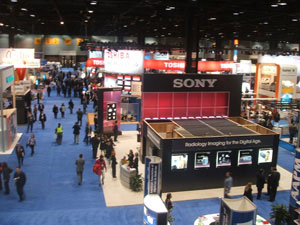 The attendance at the show was about the same as last year, 62,000 radiologists, and about 700 companies exhibited. It was notable that a number of spaces on the show floor were empty (companies that had paid for space but decided not to attend) and that the far ends of both halls in McCormick center were occupied by “Bistro RSNA”, an eating area, instead of by exhibitors. The attendance at the show was about the same as last year, 62,000 radiologists, and about 700 companies exhibited. It was notable that a number of spaces on the show floor were empty (companies that had paid for space but decided not to attend) and that the far ends of both halls in McCormick center were occupied by “Bistro RSNA”, an eating area, instead of by exhibitors.
-
- Some companies noticeably scaled back their presence, such as Siemens, and some had a large presence but still less than in previous years, such as GE.
- Of course most companies had planned their presence at RSNA well before the gravity of the economic turndown became apparent. It will be interesting to see the effect next year.
- Even companies with a large presence brought less people. For example one 3D visualization company brought 150 people to the show last year, many of them as a sort of reward (and to maximize contact with customers). This year they brought 50.
-
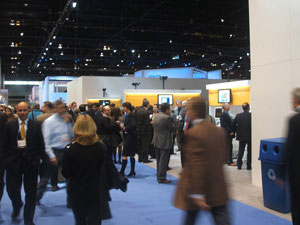 Various booth personnel who I asked said that floor traffic was about the same as last year, maybe slightly less. To me the exhibit halls felt like a crowded zoo, as always :) Various booth personnel who I asked said that floor traffic was about the same as last year, maybe slightly less. To me the exhibit halls felt like a crowded zoo, as always :)
-
- My overall impression was that exhibitors have been affected more by the economic situation than the radiologist attendees.
- The economy was a major source of discussion, but more from a personal standpoint (how people have individually been affected) than from a business standpoint (how their companies have been affected.
- The trend toward more software applications continues. The large “modality” vendors are still there (X-Ray, MRI, CT etc. equipment), but they are being eclipsed in number if not booth size by RIS + PACS vendors, CAD companies, and various other informatics companies such as voice-to-text translators. It is really hard to believe the industry can support so many companies, [apparently] undifferentiated from each other, at least at the highest level. Just about every booth contained a three+ monitor setup with a worklist on the left and various images in various stages of manipulation. The idea that radiology has gone digital is completely accepted.
-
There were a number of “Nighthawk-like” companies, providing outsourced Radiology reading services. Either at night, or offshore, or with some kind of subspecialty. With Radiology being digital, it is clear that Radiology reading can be done remotely, and a whole ecosystem is forming around this. You can imagine the same thing happening in Pathology.
-
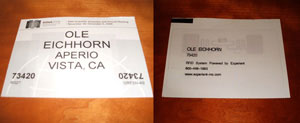 An interesting innovation; RSNA’s attendee badges included RFID tags. Every attendee’s whereabouts in the exhibit hall were continuously tracked, and supposedly each exhibitor will get a report of who visited their booth, where they came from, how long they stayed, and where they went afterward. Quite a privacy intrusion, I’m amazed they were able to get away with this without more fuss. An interesting innovation; RSNA’s attendee badges included RFID tags. Every attendee’s whereabouts in the exhibit hall were continuously tracked, and supposedly each exhibitor will get a report of who visited their booth, where they came from, how long they stayed, and where they went afterward. Quite a privacy intrusion, I’m amazed they were able to get away with this without more fuss.
-
-
It would be useful if they provided attendees with these reports; I’d love to see who-all I visited :)
-
Another useful nice-to-have, a PDA-compatible floor map. The RSNA catalog of exhibitors is too large to carry around, and the online version on the RSNA website uses a plug-in which doesn’t work on PDAs.
-
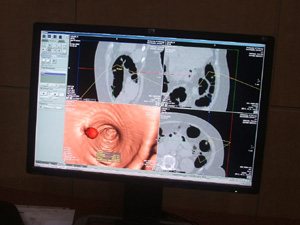 3D imaging in general seems to be a growing market area. Not only are there specialized companies like Vital Images, but virtually every major PACS vendor has some kind of 3D visualization built in to their PACS clients (often as an extra-cost option). Particularly amazing is the ability to record “paths” through a 3D image which can be played back as a “flight”. Who knew that Fantastic Voyage would become a reality? 3D imaging in general seems to be a growing market area. Not only are there specialized companies like Vital Images, but virtually every major PACS vendor has some kind of 3D visualization built in to their PACS clients (often as an extra-cost option). Particularly amazing is the ability to record “paths” through a 3D image which can be played back as a “flight”. Who knew that Fantastic Voyage would become a reality?
-
It is amazing just how many companies are in the PACS business. They each have an angle to differentiate. One which was interesting is Carestream; they feature their SuperPACS which is an inherently multi-site design with a web-based front end. This seems like the direction of the future. I spoke with a product manager there who expressed interest in pathology imaging; she said they had heard of it (but not alas of Aperio) and would probably integrating pathology viewing in the future.
-
- Most people take it for granted that when Pathology images are stored as DICOM images, existing PACS viewing software will “just work”. The idea that new capabilities are needed for panning and zooming through such large images just hasn’t taken hold.
-
There were a lot of foreign companies exhibiting; I can’t say more than last year, but it really struck me this year. Hardware from China, Japan, and Korea, and software from all over Europe. There were a lot of “not for sale in the U.S.” signs, and a lot of “not FDA-cleared” notices. Are these non-U.S. products being exhibited at a U.S. show for non-U.S. consumers? Perhaps the dollar has dropped to the point where this is feasible. And RSNA does provide a single marketplace where everyone gets together.
-
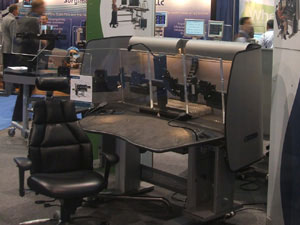 As Radiologists now spend their time looking at monitors instead of film, ergonometric workstations for Radiologists have become more popular. They range from comfortable chairs and adjustable-height desks all the way to $10,000 workstations which adjust in every possible direction and tilt, and have built in soft lighting and music. Will Pathologists need or want such workstations? Not clear… As Radiologists now spend their time looking at monitors instead of film, ergonometric workstations for Radiologists have become more popular. They range from comfortable chairs and adjustable-height desks all the way to $10,000 workstations which adjust in every possible direction and tilt, and have built in soft lighting and music. Will Pathologists need or want such workstations? Not clear…
-
Speaking of ergonometric considerations, the controls used for Radiography equipment are custom built and impressive (e.g. the joysticks used to guide X-Ray sensors into position). Makes you think about what could be done to create Pathology-specific navigation hardware for viewing digital slides.
-
It was notable that there are more and more companies which specialize in software to take voice dictations and automatically convert it into “coded” text for diagnostic reports. For years Radiologists have outsourced voice dictation (even overseas!), but now apparently more are using software to convert voice directly to text. Presumably the same software could be used for Pathology reports, the challenges are similar (e.g. correctly recognizing complex medical terms).
-
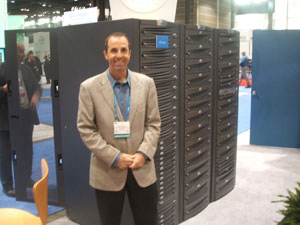 Radiology imaging requires a lot of storage (not as much as Pathology however) and there were a number of computer hardware vendors exhibiting storage, including EMC. I spent some time in the EMC booth (that’s me at right with a 1.5PB Cellera array; it could hold over 6M digital slides). It isn’t clear why these high-end storage arrays are 10+X the cost of low-end PC storage. The vendors try to make a case for their value-add (often including esoteric software features) but it just isn’t compelling. Radiology imaging requires a lot of storage (not as much as Pathology however) and there were a number of computer hardware vendors exhibiting storage, including EMC. I spent some time in the EMC booth (that’s me at right with a 1.5PB Cellera array; it could hold over 6M digital slides). It isn’t clear why these high-end storage arrays are 10+X the cost of low-end PC storage. The vendors try to make a case for their value-add (often including esoteric software features) but it just isn’t compelling.
-
- Other storage vendors present included IBM, Dell, and HP
-
The situation with “enterprise” storage solutions is reminiscent of the high-end specialized viewing displays from Barco, Planar, etc. They may be “better”, but they’re not that much better; certainly not enough to justify the significantly higher prices. It is noticeable that a few years ago “everyone” had specialized monitors for displaying Radiology images (the central monitor of typical three-monitor displays was often 16-bit grayscale), but now “everyone” just seems to use vanilla PC flat-panels. Part of the reason for this is that LCD panels have more consistent color than the CRTs they’ve replaced, but partly I think people have just realized that the extra quality of the high-end displays is just not necessary.
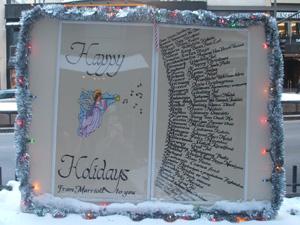 Finally I have to note (again), nothing says “Christmas” to me like a walk down Michigan Avenue in December (downtown Chicago’s premier shopping thoroughfare). There’s snow on the ground, it’s freezing, and your breath looks like smoke, but the street is beautifully lighted, there’s a ton of people out, and the stores are all decorated and warm and welcoming. For one day it’s wonderful. Finally I have to note (again), nothing says “Christmas” to me like a walk down Michigan Avenue in December (downtown Chicago’s premier shopping thoroughfare). There’s snow on the ground, it’s freezing, and your breath looks like smoke, but the street is beautifully lighted, there’s a ton of people out, and the stores are all decorated and warm and welcoming. For one day it’s wonderful.
|
|
Finally sort of settling back in after Thanksgiving weekend, my one-day trip to Chicago, and my big Five-O birthday. Today was somewhat normal :) Even managed a bike ride, in fact, I more than managed one; I set a personal best for my Rockstore loop, 1:42:47. This wasn't a white swan, either, just a steady grind with good power. Bodes well for this Saturday when I am doing a 200K, my first long ride in quite a while.
Anyway enough of my cycling, let's see what else is going on, as the Ole filter makes a pass...
Jason Kottke wonders does the broken windows theory hold online? I think it would; the same psychological factors are at work. (If you don't know, the broken windows theory is that leaving broken windows in a building will encourage people to break more windows, while fixing them promptly discourages it. This seems to be true for graffiti, for example. And I'm guess it is true for the online equivalent of graffiti, the crass thoughtless comment.) 
I noted this too; on Monday CNN issued a "breaking news alert" that the U.S. has been in a recession since December 2007. So be it, nice to know. It would have been nicer to know a year ago, but you can see where these things take time :) 
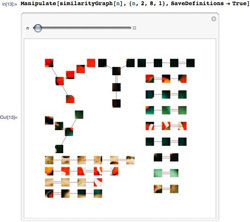 Whoa, check this out: Mathematica image processing. In which images can be input and output from an equation. I don't know if "whoa" adequately covers it, frankly, my mind is a little blown. Whoa, check this out: Mathematica image processing. In which images can be input and output from an equation. I don't know if "whoa" adequately covers it, frankly, my mind is a little blown. 
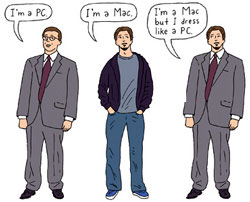 BusinessWeek reports Windows on a Mac: Virtually Perfect. I have to agree, and this capability has been incredibly helpful to me and my Mac customers. Not only do they get a good experience running my "Windows" software on their computers, but they get the latest version, and I don't have to worry about the extra overhead of developing and maintaining two versions of the software, so I can get more done for them. Excellent. BusinessWeek reports Windows on a Mac: Virtually Perfect. I have to agree, and this capability has been incredibly helpful to me and my Mac customers. Not only do they get a good experience running my "Windows" software on their computers, but they get the latest version, and I don't have to worry about the extra overhead of developing and maintaining two versions of the software, so I can get more done for them. Excellent. 
P.S. I even have a developer at Aperio who uses a Mac laptop as his everyday development computer - for Windows software :) Runs Visual Studio and everything under Parallels...
CNET reports Google reveals Chrome extensions plan. Excellent, perhaps this means someone will create an AdBlock equivalent, and then they'll be able to compete with Firefox as my everyday browser. They even quote me (!): "Of all the Firefox plug-ins, this is the one essential one. Chrome is faster until you factor in all the cruft that gets downloaded as ads, then it isn't faster anymore. When Chrome supports AdBlock, it will be the winner, but until it does, Firefox is the only choice." Well put :) 
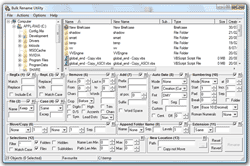 John Gruber linked this User Interface of the week. Wow! This is a real applications for renaming files. Incredible. Impressive. ... and borderline unusable :) John Gruber linked this User Interface of the week. Wow! This is a real applications for renaming files. Incredible. Impressive. ... and borderline unusable :) 
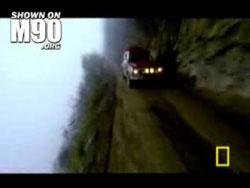 The world's most dangerous road: the Yungas. 40 miles at 12,000' from the Amazon jungle to La Paz. Seems like a nice bike ride :) The world's most dangerous road: the Yungas. 40 miles at 12,000' from the Amazon jungle to La Paz. Seems like a nice bike ride :) 
This is pretty cool: Florida teen discovers possible colon cancer cure. "Kyle Jones of The Villages Charter High School might have found a cure for colon cancer. For his science project last fall, Jones tested the effects of conjugated linoleic acid, known as CLA, an amino acid found mostly in meat and dairy products, on human colon cancer at M.D. Anderson Cancer Center in Orlando. His results showed that up to 90 percent of the colon cancer cells were killed within three days, indicating that the chemical properties of CLA could possibly be used as an effective treatment for colon cancer." How excellent. 
 Via Ottmar Liebert comes news of this $300,000 watch which does not tell time. What's next, a phone which doesn't make calls? Via Ottmar Liebert comes news of this $300,000 watch which does not tell time. What's next, a phone which doesn't make calls? 
 From John Battelle: the transition, in two headlines. I still don't "get" the online advertising thing, but then again I use Firefox with AdBlock (not Chrome :); it is undeniable that there is money to be made online (see GOOG). I do get the newspaper decline. They are definitely going the way of the great woolies... From John Battelle: the transition, in two headlines. I still don't "get" the online advertising thing, but then again I use Firefox with AdBlock (not Chrome :); it is undeniable that there is money to be made online (see GOOG). I do get the newspaper decline. They are definitely going the way of the great woolies... 
|
Return to the archive.
|


|




